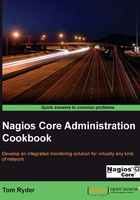
Removing a plugin
In this recipe, we'll remove a plugin that we no longer need as part of our Nagios Core installation. Perhaps it's not working correctly, the service it monitors is no longer available, or there are security or licensing concerns with its usage.
Getting ready
You should have a Nagios Core 3.0 or newer server running with a few hosts and services configured already, and have a plugin that you would like to remove from the server. In this instance, we'll remove the now unneeded check_rsync plugin from our Nagios Core server.
How to do it...
We can remove a plugin from our Nagios Core instance as follows:
- Remove any part of the configuration that uses the plugin, including hosts or services that use it for
check_command, and command definitions that refer to the program. As an example, the following definition for a command would no longer work after we removed thecheck_rsyncplugin:define command { command_name check_rsync command_line $USER1$/check_rsync -H $HOSTADDRESS$ }Using a tool such as
grepcan be a good way to find mentions of the command and plugin:# grep -R check_rsync /usr/local/nagios/etc - Change directory on the Nagios Core server to wherever the plugins are kept. The default location is
/usr/local/nagios/libexec:# cd /usr/local/nagios/libexec - Delete the plugin with the
rmcommand:# rm check_rsync - Validate the configuration and restart the Nagios Core server:
# /usr/local/nagios/bin/nagios -v /usr/local/nagios/etc/nagios.cfg # /etc/init.d/nagios restart
How it works...
Nagios Core plugins are simply external programs that the server uses to perform checks of hosts and services. If a plugin is no longer wanted, all that needs to be done is to remove references to it in our configuration, if any, and then delete the plugin program from /usr/local/nagios/libexec.
There's more...
Usually there's not any harm in leaving the plugin's program on the server even if Nagios Core isn't using it. It doesn't slow anything down or cause any other problems, and it may be needed later. Nagios Core plugins are generally quite small programs, and should not really cause disk space concerns on a modern server.
See also
- The Finding a plugin, Installing a plugin, and Creating a new command recipes in this chapter